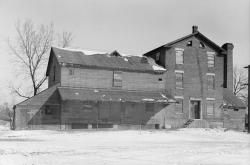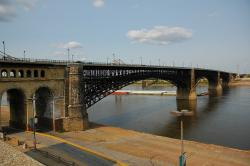IL


In the decade following the Civil War, the Mississippi River began to lose its standing as the primary transport artery in the Midwest. Railroads were taking over, and Chicago was rapidly becoming the center of Midwestern commerce. The Eads Bridge was the first major railroad link over the Mississippi, constructed by the city of St. Louis in an attempt to maintain its dominance as a regional commercial hub.

In 1899, engineers from the City of Chicago's Division of Bridges and Viaducts performed a survey of moveable bridge design in the U.S. and Europe. Their study led to the conclusion that the unusual trunnion bascule design would best meet their needs.

The Chicago, Burlington, & Quincy Railroad was the first railroad to link Chicago and the Mississippi River, in the 1850s. This forty-stall roundhouse, large even for its time, became a major center for railroad activity for the CB&Q. It served as a repair and construction facility from which more locomotives and cars than any other CB&Q installation were built. Steam engines, passenger cars, freight cars, precision parts, tools, and machines were designed and built, beginning about 1858.


